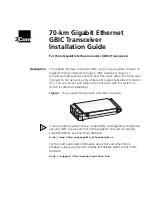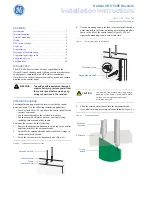
Cabling Types
4-15
Ethernet Media
Fiber optics of both types are measured and identified by a variety of means. The
usual means of referring to a fiber optic cable type is to identify if it is single mode
or multimode, and to describe the thickness of each strand. Fiber optics are very
thin, and the diameter of each strand is measured in microns (
µ
m). Two
measurements are important in fiber optic identification; the diameter of the core,
where signals travel, and the diameter of the cladding, which surrounds the core.
Thus, fiber optic measurements will usually provide two numbers separated by
the “/” symbol. The first number is the diameter, in microns, of the core. The
second is the diameter of the cladding. Thus, a 62.5/125 multimode cable is a type
of fiber optic cabling with a 62.5 micron core and 125 micron cladding, which is
commonly used by LED driven transmitting devices.
In much the same way that UTP cabling is available in two-, four-, 25-, and 50-pair
cables, strands of fiber optic cabling are often bound together with other strands
into multiple strand cables. These multiple strand cables are available with
anywhere from two to 24 or more strands of fiber optics, all gathered together into
one protective jacket.
Multimode
Multimode fiber optic cabling is designed and formulated to allow the
propagation of many different wavelengths, or modes, of light. Multimode fiber
optics are the most commonly encountered fiber type in Ethernet installations,
due to their lower cost compared to other fiber types.
Multimode fiber optics may be terminated with any type of fiber optic connector;
SMA, ST, FDDI MIC, or the new and not currently standardized SC connector.
TIP
Cabletron Systems recommends that customers planning to
install fiber optic cabling not install any facility fiber optics
(non-jumper cabling) containing fewer than six strands of
usable optical fiber. The minimum number of strands needed to
make an end-to-end fiber optic link between two network
devices is two (using the Ethernet network architecture). In the
event that a strand within the cable is damaged during
installation or additional fiber pairs become desired along the
cable path, the availability of extra strands of optical fiber will
reduce the likelihood that a new cable must be pulled. The
existing, unused pairs of optical fiber can be terminated and
used immediately.
Summary of Contents for 100BASE-FX
Page 1: ...Cabletron Systems Cabling Guide...
Page 2: ......
Page 4: ...Notice ii...
Page 22: ...Cabling Terms 2 8 Test Characteristics...
Page 54: ...Ethernet Media 4 30 Connector Types...
Page 72: ...Full Duplex Ethernet Network Requirements 6 8 Ethernet FOIRL Single Mode...
Page 80: ...Fast Ethernet Network Requirements 7 8 Hybrid Installations...
Page 130: ...FDDI Media 11 16 Connector Types...
Page 136: ...FDDI Network Requirements 12 6 TP PMD STP...
Page 170: ...Connecting and Terminating 14 20 FDDI...
Page 192: ...Index 4...
















































